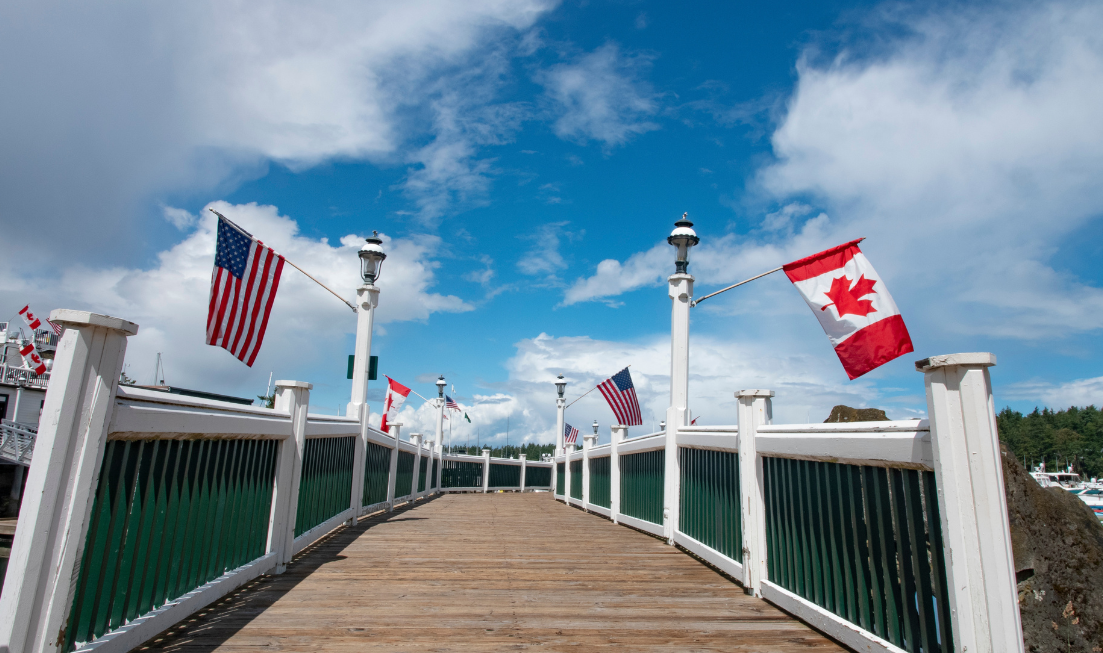Expert analysis: As tariff threats rock the Canada-U.S. relationship, what now?

Political scientist Andrea Lawlor explains the effects of Donald Trump’s tariff talk on the next federal election, Trudeau’s legacy and how Canadians’ perception of the U.S. is changing.
BY Chris Pickles, Faculty of Social Sciences
February 14, 2025
From booing the U.S. anthem to boycotting American goods, the reaction to President Donald Trump’s tariff threats has been significant.
 Andrea Lawlor, associate professor of Political Science, shares expert insights on the effects of tariff talk on Canadians’ perception of the U.S., the future federal election, and Justin Trudeau’s legacy.
Andrea Lawlor, associate professor of Political Science, shares expert insights on the effects of tariff talk on Canadians’ perception of the U.S., the future federal election, and Justin Trudeau’s legacy.
Broadly speaking, how do you think Trump’s tariff threats have affected Canada’s relationship with the U.S.?
The phrase “existential crisis” keeps getting thrown around in the media, and at first it was easy to see that as hyperbole. However, I think the current state of Canada-U.S. relations represents a deep rupture to one of the most fundamental aspects of our economy that we so rarely question: The liberal trade order and its effects on goods and services we have come to expect in our daily lives. Canadians are seeing it start to crumble.
And when you couple that with bold, highly politicized statements like “Canada should be the 51st state,” it comes together to shake up some Canadians’ foundational notions of the country as a sovereign state and the relationship that we have with our closest trading partner and ally.
Have these threats affected how Canadians view our trade relationship with the U.S.?
The seamless nature of the flow of people, goods and services across our border has been crucial in developing the strong bonds between the two countries, but it’s not something that Canadians or Americans think a lot about because it has been our reality for so long.
Until recently, Canadians probably didn’t consider where their goods come from, how they’re made, or how integrated our supply chains are. It has been such a stable feature of our lives since the North American Free Trade Agreement, which came into effect in 1994.
Take the auto industry: Cars might be assembled in Canada, but parts will come from the U.S., Mexico and elsewhere.
It applies to our agricultural products, too. The beef that we eat could be considered Canadian because it’s raised in Canada, but it might be and packaged and distributed through an American meat-packing plant.
So there’s a lot of cross-border elements to our daily patterns of consumption that we don’t typically pay a lot of attention to and that’s quite simply because the relationship between the two countries has been so close, and so integrated for so long.
But these threats have cast that relationship in a different light.
How are people reacting to the change?
It is worth noting the highly emotional reaction that Canadians have had to the aggressive statements made by President Trump. I’ve heard the language of “betrayal” being used — that Canadians feel betrayed by the undermining of this historic relationship by the actions of one administration that has been in power for less than a month.
What can Canada do to respond?
Some trade experts and economists have pointed to the potential for two things to happen.
The first is to bring down interprovincial trade barriers. Last week, Transport Minister Anita Anand announced there would be probably some changes to interprovincial trade barriers.
That is something that we can do domestically, but it’s a conversation that’s been going on for well over 30 years and there have been few changes over that time. It would take a large effort to address these barriers, though the political will may finally have arrived to move on this longstanding policy issue.
The second piece is asking whether we could we diversify our trade outside of the U.S. That is even trickier for two reasons.
- The first is the strong gravitational pull of the U.S. It’s not just the size of their market; it’s the physical location of our two countries.
It’s one thing to ship across from Windsor to Detroit or Hamilton to Buffalo. It is quite another to trade with countries where the infrastructure is planes or boats that take a lot longer and are more expensive, because those costs do get passed on to consumers. - The second is that trade agreements are very robust legal frameworks for the exchange of goods and services, and these things are notoriously difficult to hammer out over time. Creating that greater degree of liberalization or freer trade between us and the U.K., the E.U., China, other trading partners, is a longer-term process.
Altogether, this is something that Canadian policy makers will continue to look at as they recover from the cold bucket of water that’s been thrown on their heads.
This recent episode is a reminder that we can’t be solely dependent on our trade relationship with the U.S. We may have to consider different, bilateral trade arrangements and ramping up domestic production capacity. All of this comes with costs to the consumer.
A federal election is looming. How could this affect federal politics?
We’re still a month away from the Liberal leadership vote, but recent events have put Mark Carney on a path to success in his Liberal leadership bid. His experience with fiscal policy is going to come in extraordinarily handy in the next little while, and he doesn’t have the same fractious relationship with the Trump administration as his main competitor (former finance minister Chrystia Freeland).
He’s coming off looking like the “adult in the room,” notwithstanding some limitations he may have in attracting votes around the country.
It has also forced Conservative Leader Pierre Poilievre to pivot a bit. He was getting a lot of traction with his “Axe the tax” and “Build the homes” messaging, but two things have taken the wind out of his sails.
The first and most obvious is the focus on tariffs and trade across borders, which is not an area where he has been particularly vocal in the past.
And the second is that if he can no longer work on his successful messaging around the carbon tax, especially now that most candidates for the Liberal leadership have decided they’ll pull that policy anyway, he must walk a very fine line now about how to talk about Trump and tariffs.
He must appear very competent on the issue while neither alienating Trump nor looking overly friendly.
There’s a careful balance that he must maintain because some of the base he has cultivated might also support Trump, but he has to court the moderate Canadian whose vote may be up for grabs.
The final interesting dimension, and I didn’t think I would be saying this, is that it’s given Justin Trudeau an interesting window of opportunity to use the time he has remaining to rehabilitate his image, which has become quite tarnished over the last few months.
As a lame duck prime minister, he’s probably been a little bit bolder in his statements than he might otherwise have been if he was concerned about fighting an election.
This is an interesting, and perhaps unexpected, opportunity for Trudeau to go out on a higher note than we might have expected without this crisis.


